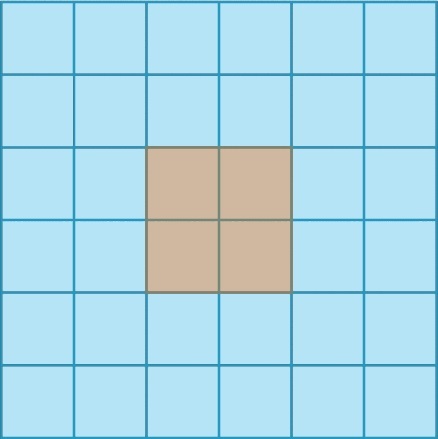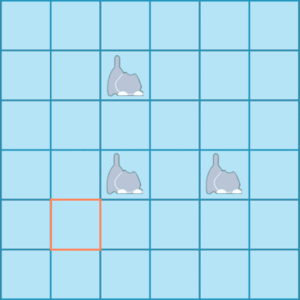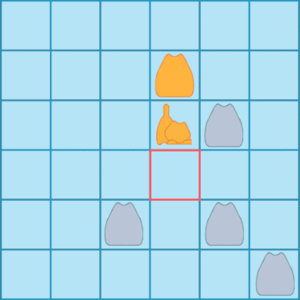This is a documentation for Board Game Arena: play board games online !
Tips boop
Tip #1 - Have more pieces on the board than your opponent
Having more pieces on the board than your opponent does not mean you're winning because the positioning of the pieces also matters. But having more of your pieces on the board give more opportunities to create threats and earn three-in-a-rows.
Here's a reductionist model of viewing the game from a materials standpoint:
When you place one piece on the board, that's a +1.
When you place one piece on the board while booping an opponent's piece off the board, that's a +1 for you and a -1 for your opponent. We could say that the net value of your move is a +2.
When you place one piece on the board while booping two of your opponent's piece off the board, that's a +1 for you and a -2 for your opponent. We could say that the net value of your move is a +3.
When you place one piece on the board while booping three of your opponent's piece off the board, that's a +1 for you and a -3 for your opponent. We could say that the net value of your move is a +4.
When you place one piece on the board but boop one of your own pieces off the board, that's a +1 and a -1 for you. We could say that the net value of your move is a 0.
This leads to some obvious conclusions:
Tip #1.1 - Avoid having your pieces at the perimeter because they can be booped off in just a single move.
One of the worst positions is when you have multiple pieces clustered near each other at the perimeter because the opponent can boop several of your pieces in one move.
Tip #1.2 - A single move that boops multiple of your opponent's pieces off the board is a good move.
Conversely, if you can boop your opponent's pieces to be clustered near each other on the perimeter, that sets you up to boop several of their pieces in one move. This is often how you can have more of your pieces on the board than your opponent's pieces.
Tip #1.3 - Don't waste time setting up a three-in-a-row along the perimeter unless you have a good reason to.
A common rookie mistake is forming two kittens in a row along the perimeter. But the opponent can boop two of your pieces off the board in a single move.
There are exceptions. For example, if your move created a situation where you have two sets of two kittens in a row, you have a double threat. Your opponent can disarm one of your threats, but you can form three-in-a-row with the remaining threat.
Center - On the 6x6 board, the four center squares are often the best spots to be in - as shown in Figure 1. They are the furthest away from the edges of the board, making those spots the hardest to push off the board. The closer your pieces are to the edges, the easier it becomes to push them off the board itself.
L-Shape - This shape is a set up for getting three-in-a-row. If anyone plays at the corner (Figure 2), it would push the kitten in the corner into a three-in-a-row. This does not work if the corner of the L-shape is up against the edge.
Ranking of three-in-a-rows:
1) Three Cats in a row = Winning condition
2) Three Kittens in a row = Most profit. You take three pieces off the board in exchange for three promotions.
3) Two Kittens + One Cat = Moderate profit. You take three pieces off the board in exchange for two promotions.
4) One Kitten + Three Cats = Least amount of profit. You take three pieces off the board in exchange for one promotion.
Number of pieces both on and off the board - an important strategy is to note the number of kittens and cats both you and the opponent have in their pool.
- 8 pieces - While fighting to get three-in-a-row, one must not forget that there are alternatives to gain cats. Don't forget that if the opponent has all 8 of their pieces on the board, they get to promote one of their kittens into a cat at the end of their turn. Therefore, it's important to keep track the number of a player's pieces on the board as it approaches eight. And do remember that having all eight of a player's cats on the board is an alternative victory condition.
- Non-Threats - If the opponent has 2 cats in a row, one's instinct might be that they're about to win if given a free turn. But that's only a threat if they have a cat in their pool. If they do not have cats left in their pool, then you do not have to immediately worry about it. Blocking their win condition may no longer be necessary because the opponent lack the resources. Furthermore, when it comes to getting three-in-a-row, a line composed of 2 cats and 1 kitten is the least efficient way of getting cats, so sometimes, you may want to bait the opponent into getting three in a row (2 cats and 1 kitten) because it removes three of their pieces off the board while only profiting one additional cat. And simultaneously, you try to set yourself up for more profitable three-in-a-rows such as 2 kittens + 1 cat or 3 kittens.
Advanced Tactic: Anti-Blocking - When you get two cats in a row, you are one cat away from winning the game. A common countermeasure is for the opponent to play a piece that occupies the spot that would enable your three-in-a-row. But there are situations that can be created where blocking is impossible such as in Figure 3. The grey cats are at the brink of getting three in a row, but the opponent cannot block it because once they do, they have established three-in-a-row which gets taken off the board, opening up the position for the grey cats to win the game. In such situations, getting three-in-row completely backfired onto the opponent because according to the rules, a three-in-a-row should be checked and removed at the end of a player's turn.


